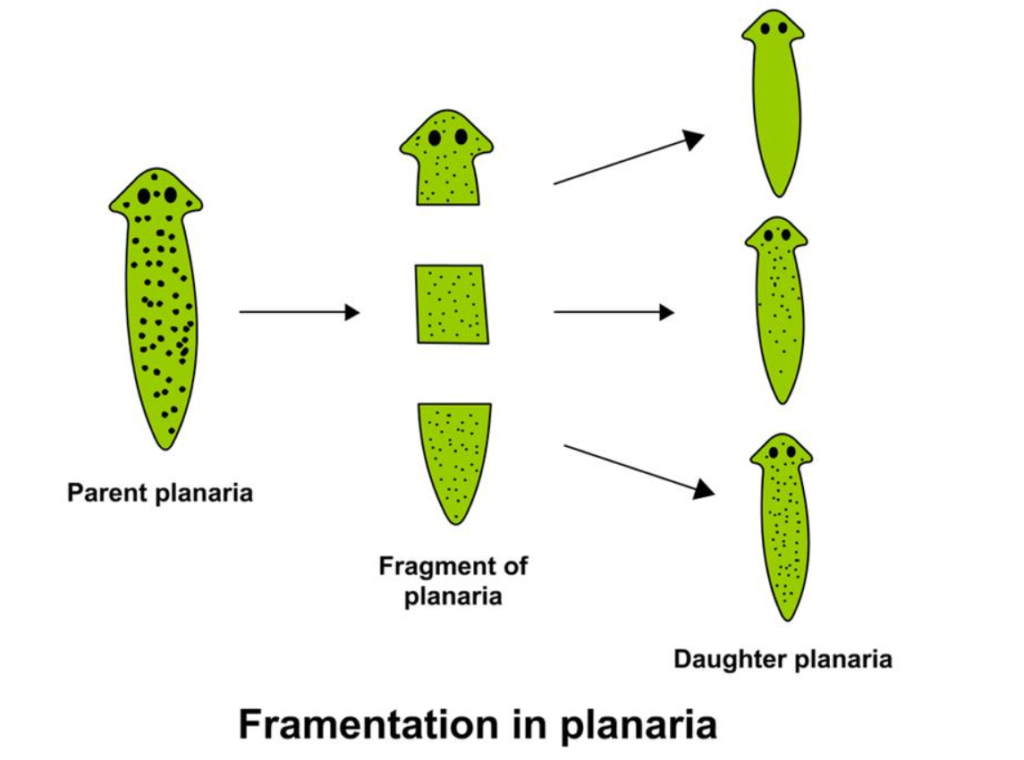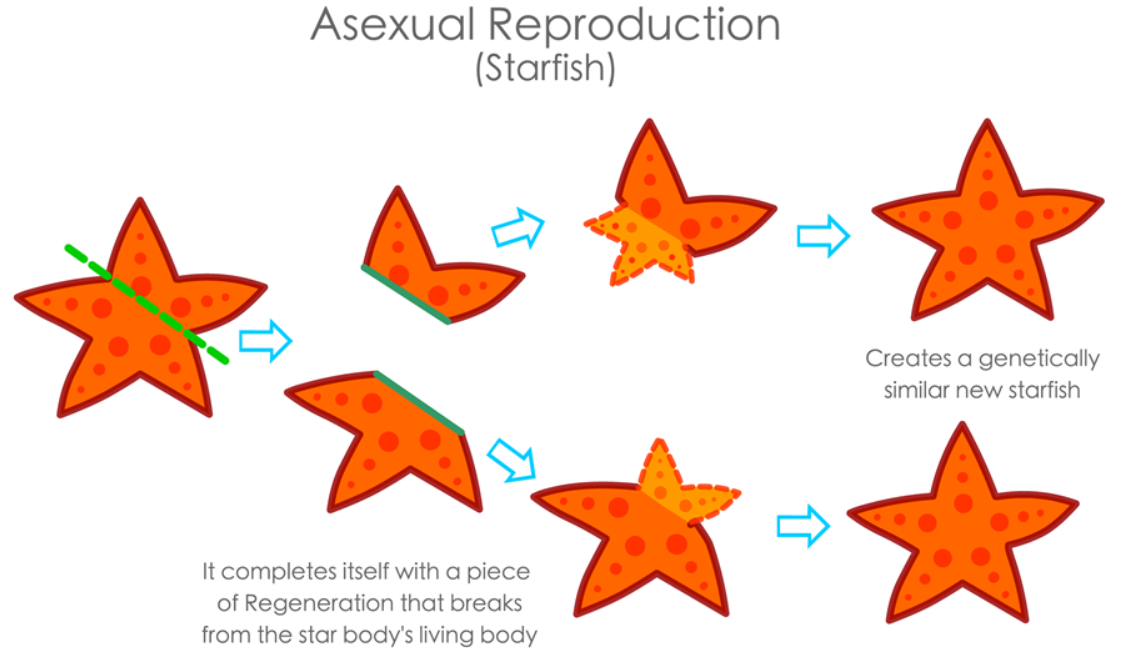Understanding Distinctions Between Regeneration and Fragmentation
What Is Fragmentation?
Asexual reproduction by fragmentation is an intriguing process. In this process, a parent organism splits into discrete pieces. Each piece can grow into a fully functioning organism. This reproductive method proves beneficial in environments where rapid population increase is necessary for survival. Organisms that reproduce by fragmentation can quickly colonise their environment, ensuring the survival of their genetic lineage.
Examples of Fragmentation in Nature
Some species of starfish provide a notable illustration of fragmentation. A starfish can grow new limbs when threatened or injured. Under the right conditions, severed limbs can develop into whole new starfish. This extraordinary capacity not only helps the organism survive but also enhances the population’s resilience. Similarly, many plants use fragmentation as a propagation strategy. Aquatic and succulent plants, for example, may establish themselves as new individuals when fragments break off under the right conditions.
Key Elements in Fragmentation
Different species follow varying processes for fragmentation, but most include some key elements. To regenerate missing parts, the parent organism must have specific cellular structures. The fragments also need access to enough water, nutrients, and favourable environmental conditions to survive and develop. In unstable or unpredictable environments, where traditional reproductive strategies may be hindered by predator pressures or environmental changes, fragmentation is often preferred.
Ecological Roles of Fragmentation
Fragmentation fulfils several important ecological roles. It promotes resistance to environmental changes and guarantees genetic variety within a population. Fragmented organisms can aid in the reestablishment of communities in damaged habitats. This reproductive mechanism also helps with habitat restoration. In some ecosystems, fragmentation plays a vital role in fast population growth and improving species dispersion. This, in turn, impacts the sustainability and health of those ecosystems.
Regeneration: What Is It?
Understanding the Process of Regeneration
Regeneration is the remarkable biological process that allows organisms to replace or repair damaged or destroyed tissues and organs. This capacity varies greatly across species and is an essential survival strategy. It helps organisms heal from wounds or adapt to changing environmental conditions. Regeneration can be categorised into two main types: physiological regeneration and complete regeneration.

Physiological Regeneration
Physiological regeneration refers to an organism’s inherent repair mechanisms. This process includes the regeneration of tissues with a high turnover rate, such as skin, liver, and blood. Human skin, for instance, can effectively heal small wounds and abrasions due to its constant renewal. This type of regeneration demonstrates how organisms maintain their general functioning and homeostasis without major losses.
Complete Regeneration
Complete regeneration, on the other hand, involves the restoration of whole organs or limbs. Salamanders, for instance, can regenerate limbs, tails, and even parts of their hearts and eyes. This ability is often cited as one of the best examples of complete regeneration. Research shows that the complex cellular mechanisms and chemical cues that direct tissue growth enable these creatures to fully replace destroyed parts. Similarly, flatworms known as planarians have extraordinary regeneration abilities that allow them to regrow a whole new body from just a small fragment.
The Role of Stem Cells in Regeneration
The cellular and molecular processes driving regeneration are complex and still under study. Stem cells play an essential role in regeneration because they can differentiate into multiple cell types required for tissue creation. Understanding the precise genes and pathways involved in regeneration is crucial. This knowledge not only provides insights into embryonic biology but also has significant implications for regenerative medicine. It could aid in treating degenerative diseases or injuries in humans.
The Significance of Regeneration in Evolution
Regeneration is a prime example of life’s remarkable flexibility. It showcases various evolutionary tactics that improve species survival. By allowing organisms to heal and regenerate, this process enables them to adapt to injuries and environmental changes, thus increasing their chances of survival.
Important Distinctions Between Regeneration and Fragmentation
Fragmentation vs Regeneration: Key Differences
Although fragmentation and regeneration are often discussed together in biological contexts, they are two distinct processes with different definitions, characteristics, and effects. Fragmentation is a form of asexual reproduction where organisms split into fragments, each capable of becoming a new individual. This mechanism is most visible in certain plant species, sponge species, and starfish species. Organisms that use fragmentation generally have faster reproduction rates because even a small fragment can develop into a whole, functional organism.
Regeneration: Repairing Damaged Parts
Regeneration, on the other hand, is the biological process by which organisms replace or repair damaged tissues, organs, or limbs. This ability is often seen in species like salamanders and certain echinoderms, where complex structures can be rebuilt. Regeneration typically takes longer than fragmentation and involves a more intricate biological response, including cellular reorganisation. Unlike fragmentation, which creates new individuals, regeneration maintains the integrity of the original organism.
Ecological Impacts of Fragmentation and Regeneration
Fragmentation can significantly influence population dynamics because it can rapidly increase population size without the need for intricate breeding patterns. Regeneration, however, enhances individual fitness and survival rates, helping organisms endure harm or predation. These differences affect ecological balance. Regeneration helps maintain populations by enabling individuals to recover from depletion, while fragmentation can lead to sharp increases in species numbers. An infographic or table comparing these traits could make the differences clearer in the context of biological and ecological research.
Research Applications and Significance
The Importance of Understanding Fragmentation and Regeneration
Understanding the differences between fragmentation and regeneration is crucial in many scientific and practical domains. These processes have broad implications in ecology, conservation biology, and regenerative medicine, in addition to being fascinating topics of study. Insights into regeneration—the capacity of organisms to repair or regenerate damaged structures—and fragmentation, which often refers to the breakdown of species or ecosystems, can inform many real-world applications.
Regenerative Medicine and Its Use of Regeneration Concepts
Regenerative medicine is one area where the principles of regeneration have real-world applications. This field aims to develop treatments that replace or repair damaged organs and tissues. With tissue engineering and stem cell therapy at the forefront, regenerative medicine is progressing rapidly. This discipline holds the potential to revolutionise our understanding of ageing and tissue damage.
Fragmentation and Conservation Biology
In conservation biology, understanding fragmentation is essential to preserving biodiversity. Fragmented ecosystems often face problems such as reduced genetic diversity, weakened species resilience, and increased vulnerability to climate change. By studying fragmentation, researchers can create more effective strategies for protecting species and preserving habitats. For example, establishing wildlife corridors can reduce the negative effects of habitat fragmentation, helping to improve species survival and ecological balance.

Ecological Insights from Fragmentation and Regeneration Studies
The study of fragmentation and regeneration also provides valuable insights into ecosystem dynamics. This knowledge is crucial for understanding how human and natural factors influence the stability and recovery of habitats. Investigating the mechanisms that drive these processes, including the genetic and environmental factors affecting different species’ regeneration abilities, is an important area of research.
Future Research in Fragmentation and Regeneration
It is clear that ongoing research into the connection between fragmentation and regeneration will continue to evolve. Advances in technology, such as environmental modelling and genetic analysis, are expected to provide more insights into these processes. This research will not only deepen biological understanding but also offer practical applications that could help address global challenges such as ecological restoration and habitat loss.



